Companion planting around fruit trees 101
Love to grow fruit? Me too! Hang out with me for a bit. Learn with me how you can improve the health and productivity of your fruit trees by planting beneficial plants near your trees. This is known as companion planting or planting a fruit tree guild. This is serious planting geekery and ergo super-fun, folks. Join me!
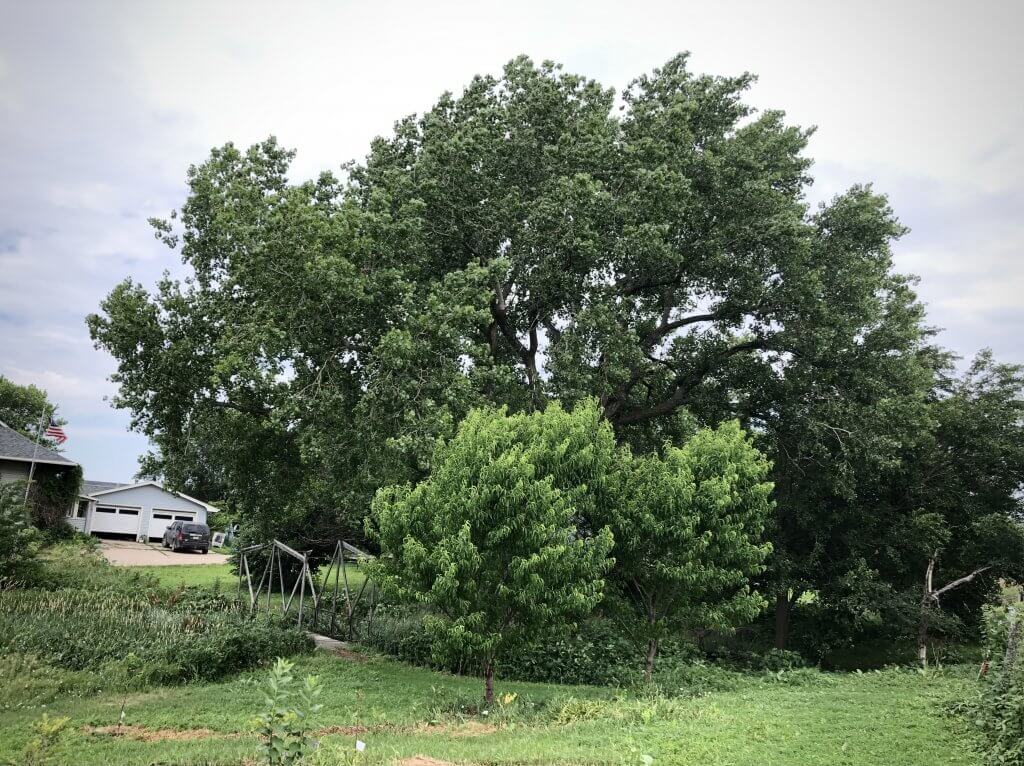
The two special peach trees that I’m giving some special attention this summer are in the foreground, in front of a 100+ year-old Cottonwood tree.
What goes on around here
Longsuffering hubs Bryan might be a bit astonished if he knew how many fruit trees I added to our landscape this spring. Heck. I’m a little astonished, myself. He might possibly even be flabbergasted. Gobsmacked. Struck dumb, maybe.
I was so unnerved by his imagined reaction (“you ordered how many fruit trees???”) that I didn’t even ask for help in planting them. (I usually do–I’m not the strongest hole digger). True, I didn’t exactly go out in the dark of night to plant them all, but I did dig the holes quietly. Stealth was the name of my planting game. Clever, quiet me. If I may say so.
In defense of this profligate fruit tree purchase . . . . I am the fruit eater in the family. Bryan and Mack will fill their plates with meat, bread, the odd vegetable, and then notice loudly that there’s no room on the plate for watermelon. Shucks! Or apple slices. Nor the fruit salad. Can you imagine??
No Room For Fruit
is not a phrase that will ever darken my mulberry-stained lips, no sirree bob.
I can’t. Imagine it, that is. But then I was the girl who tried to coax her mother to make an only-fruit dinner at least once a week. A great big ole’ platter of fruit. Maybe a few slices of cheese, too, would not have gone amiss. A slice or two of homemade bread (warm). But that’s it. Simple needs.
Also (do I sound a tad defensive?) I’m the seed catalog and fruit tree website peruser in the family. Thirdly: one can’t really help it if one orders, say, six fruit trees last fall, then maybe forgets about them. Then possibly the same one may order another five trees during the cold, grey, forgettable winter months.
I personally would have grace for such a forgetful One. Probably the same one pushed that memory far back in the everglades of her memory swamp, after all.
Oh, that memory swamp
. . . getting murkier and murkier.
The final six fruit trees I ordered because–you know–I simply couldn’t help it. It was springtime, you see, and there were such fabulous SALES then.
I’m sure you’d agree that there’s nothing at all to be criticized in all this industry. But my hubby might not agree with you. He might think that little ole’ moi might not be able to handle seventeen more fruit trees. But I could coax him to my way of thinking, if we ever chose to talk about this plethora of brand new fruit trees. But (I assure you) we won’t.
Since he hasn’t actually noticed them yet.
Besides.
As the gas prices continue to jump up a dime, twenty cents, thirty cents at a time, we’re staying home more. Pretty soon, we’ll not be able to afford to go anyplace, so I’ll have plenty of time to prune fruit trees. And who knows when the stores will suddenly have no apples?
Stranger things have happened in the past couple of years.
Fruit trees are easy to grow, but do need a modicum of care and maintenance to produce abundant and beautiful fruit. Some years I do better than others at keeping my orchard maintained. It takes practice, and I’m adding onto my fruit tree maintenance skillset in many ways.
I’m going to share the things I’ve learned in twenty years of orchard management, and then I’ll reveal the exciting new project that I’m working on this year. Super-duper stuff. Exciting and totally do-able. Just wait!
Three things I do to improve the health of my fruit trees
- I mulch heavily around the base of my trees (but pulled back from the trunks, natch’) to keep the precious moisture in the ground as long as possible. This practice also serves to discourage the evil yet amazing prairie grass from competing with the trees for nutrients and moisture. I was the recipient of copious amounts of wood chips from a couple of tree trimmer friends. (And, my dear gentle reader, if you don’t have a tree trimmer friend, go out and find yourself one, asap!) These piles have been an unmitigated blessing.
- I bought a handy little saw similar to this one (fitted with a saw blade especially for wood) and I’ve swooned happily over it every day since. It’s powerful enough that I don’t have to ask the (constantly and forever longsuffering) hubs to do any sawing for me except for the largest branches, and light enough that my puny little ole’ hands can operate it without too much trouble. Every old lady orchardist ought to have one. Young ones too, for that matter.
- I hang jugs of this solution in my fruit trees in the spring, just as the blossoms are beginning to open. They do attract moths (particularly the codling moth that makes such a mess of the apples) and they seem to keep my fruit from being so buggy.
- I don’t do the recommended spraying. (Have you read the fine print on the containers of fruit tree spray? Do. You may re-think spraying, as well.)
Okay, that was four.
And now, the pièce de résistance . . .
This is what I’m doing this year, a new experiment and the actual topic of this post. I’m experimenting with planting beneficial plants around my fruit trees. (It is just as thrilling as it sounds!)
Plant fruit tree guilds around your fruit trees!
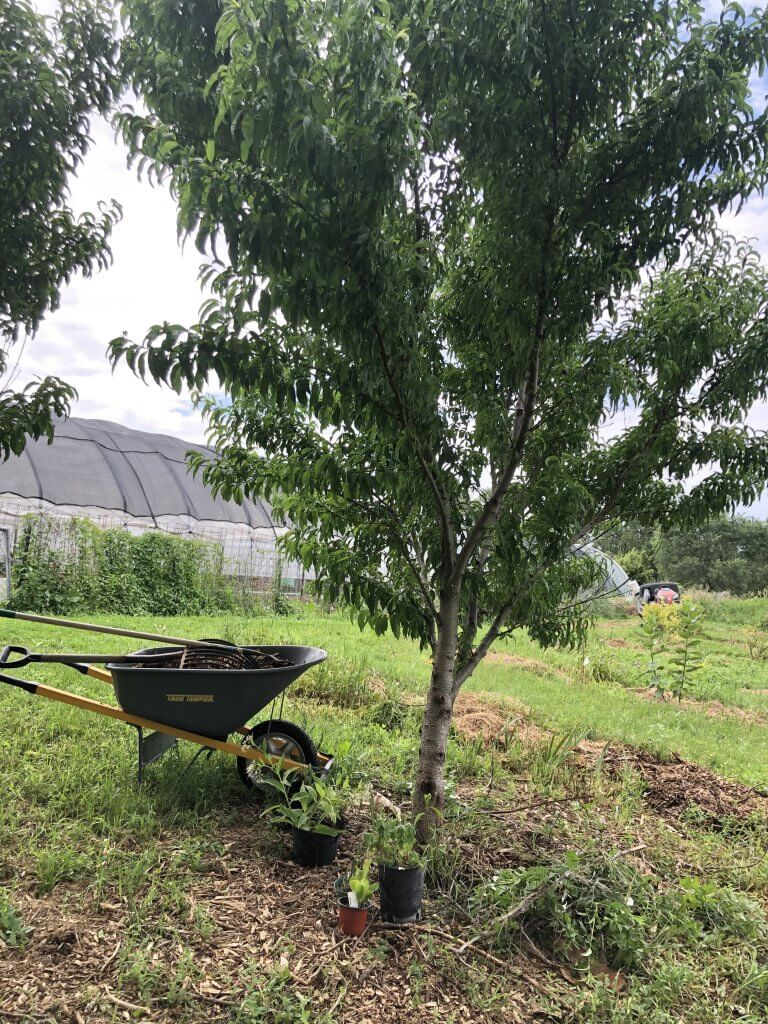
Before . . . I’ve assembled my companion plants, a shovel, and a wheelbarrow full of mulch.
So—-I’ll bite, you say.
. . . what is a fruit tree guild?
So glad you asked! A fruit tree guild is a permaculture method of planting a fruit tree in combination with other plants. They all then grow together to create a mini ecosystem around the tree.
There hasn’t been a lot of scientific study of tree guilds but they show a lot of potential.
The six categories of plants that make up fruit tree guilds
and a quick(ish) definition of each.
- Suppressors: plants that suppress weed growth. Some good examples: vining winter squash, which will shade out weeds, or mint which grows faster than weeds. (Here’s an interesting article, from which I gleaned much of this information.) Another good suppressor might be strawberries, which would provide edible berries. (And a bonus: their early flowers help to draw in pollinators.)
- Attractors: plants that attract pollinators and other beneficial insects to the tree. Some examples include yarrow, buckwheat, butterfly weed, and mustards. Many other species can be used as well, but what’s important is to use plants that will work well for your tree. For a peach tree guild, which I’m working on currently for example, cosmos is a good choice. Cosmos (and many other orange and yellow flowers) attract trichogramma wasps, which are helpful beneficial insects and a natural enemy of oriental fruit moths, which can severely damage peach trees. Note: You can plant these plants within 25’ of the tree to attract pollinators. They don’t have to be as close to the tree as plants that repel pests or improve the soil. Attractor tip: Plant a perennial bed or a sweep of wildflowers outside of the canopy so the flowers get plenty of sun. And one more thing: Any plant that attracts pollinators will benefit a fruit tree.
- Repellers: these plants repel pests that want to feed on your fruit tree. Lemon grass, marigolds, lemon balm, and almost any allium like garlic, chives, or perennial onions are all commonly used to repel pests. (Egyptian walking onions would be an excellent choice, and a side benefit is that they multiply like mad once you get them started.) Knowing your specific tree’s common pest issues will help in choosing what to plant. For my peach trees, for example, garlic or garlic chives might be a great choice since there is evidence that planting garlic around peach trees helps repel peach tree borers.
- Mulchers: Comfrey is probably the most commonly used mulching plant. I have quite a large patch of it myself and can attest to its value as mulch! It’s also hardy, perennial, super easy to grow, and when it is covered in blossoms it draws in pollinators like crazy! Hostas can be used the same way, and would be less apt to outgrow the area. Some growers also use annual cover crops like buckwheat that winter kill and provide good mulch. (It’s comfrey for me, though. I’m a big fan of comfrey!)
- Accumulators: plants that pull nutrients from deep in the soil and bring them to the surface where other plants will be able to use them. Comfrey again stars in this role, as well as alfalfa, borage, and chicory. I’ve got some horseradish that I’m planning to experiment with in this use, as well.
- Fixers: “nitrogen fixing” means that these plants add nitrogen to the soil as they grow. White clover, red clover, beans, alfalfa, lupine, and peas are all great examples of nitrogen fixing plants. Since we’re still working on a peach tree guild, I will plant beans (as I have some extra seeds) and I know as they bloom, they’ll attract pollinators and beneficial insects including trichogramma wasps. (I really like to grow beans, and I’ve planted a ton of them this summer!)
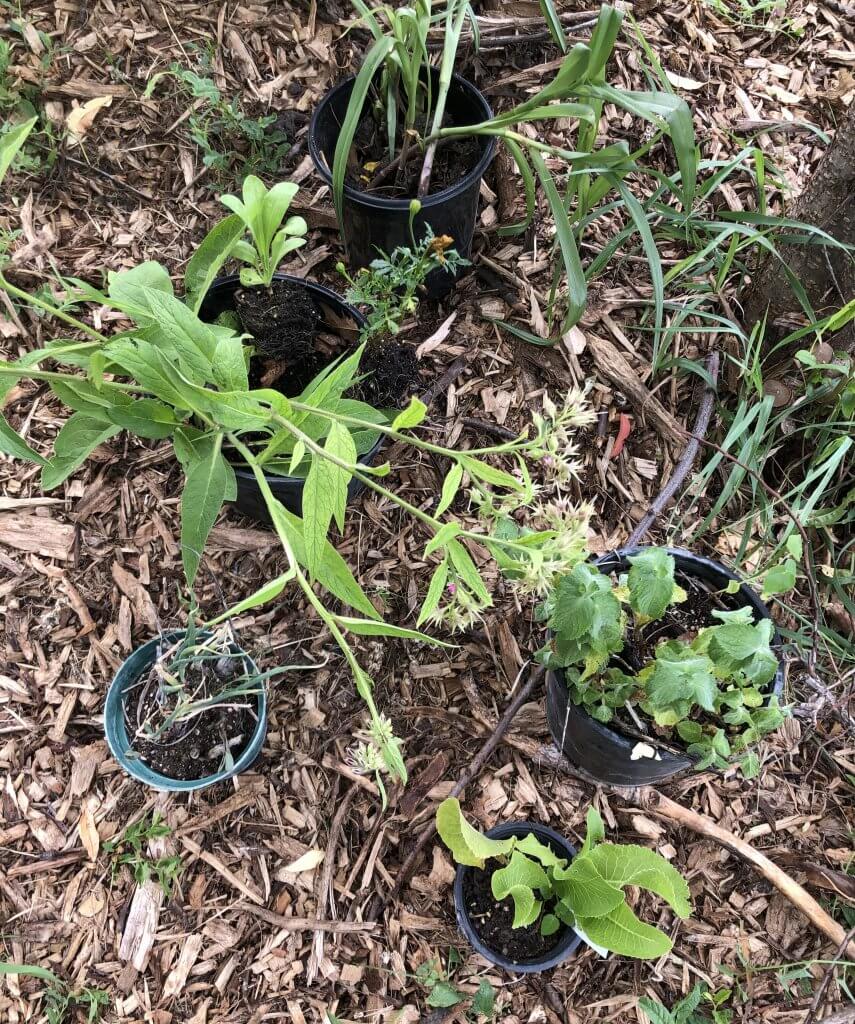
From small green pot on lower left, moving clockwise: Egyptian walking onions, comfrey, calendula and marigold, spiderwort (my mom gave it to me and I needed a place to plant it), mint, and horseradish.
These are the six most commonly-used types of beneficial plants to locate around your fruit trees. There are variations, naturally. Of course there’s no rule that you have to plant all of these, or even that you can’t focus on one category or two. There are no rules, period. If you see a need in your orchard, you may even make up your own category, which is very cool and smart of you!
For example
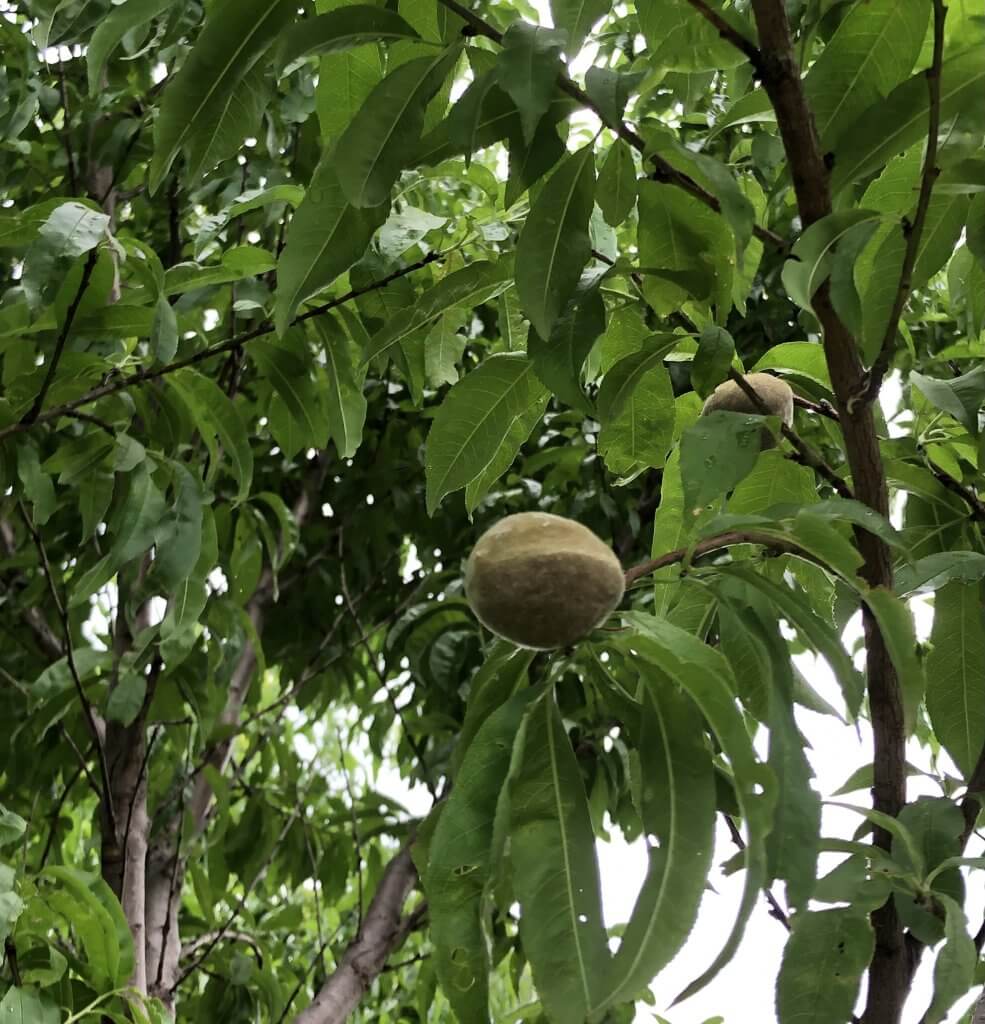
Black Boy peaches. *swoon*
My project this week is to plant guilds around my two Black Boy Peach trees. I planted them on a slope near my chicken coop several years ago. I honestly don’t know if I’ll ever eat fruit from these trees, since we nearly always have a late freeze that destroys the blossoms*. (*News flash! I wrote that line the day before I spotted a couple of small peaches in one of my trees! *see photo above*)
Here’s what I’ve chosen to plant around these two trees:
- Comfrey will accumulate nutrients from the soil and also act as mulch. Comfrey is an enthusiastic plant, and when the plant becomes a monster, I’ll chop the leaves and put them down as mulch. (And remember, honeybees, Bumbles, and other pollinators love comfrey!)
- Mint will suppress weeds. (Note: mint is an aggressive grower, but since I mow the grass around these trees, I don’t mind if it wanders out into the grass.)
- Fennel will attract those beneficial wasps.
- Egyptian Walking Onions and Chives are the repellers that I’ve chosen to plant around these trees, as I have both in abundance and they are so easy to grow.
- A few bean plants are great nitrogen fixers, and I’m going to add that to the peach tree guilds, as well.
Gentle reader, this is all an experiment for me, honestly, but I’m super excited about it! I’ll report back on this project of mine. Be sure to add your email address to my list (in the little box up to the right) so you don’t miss updates.
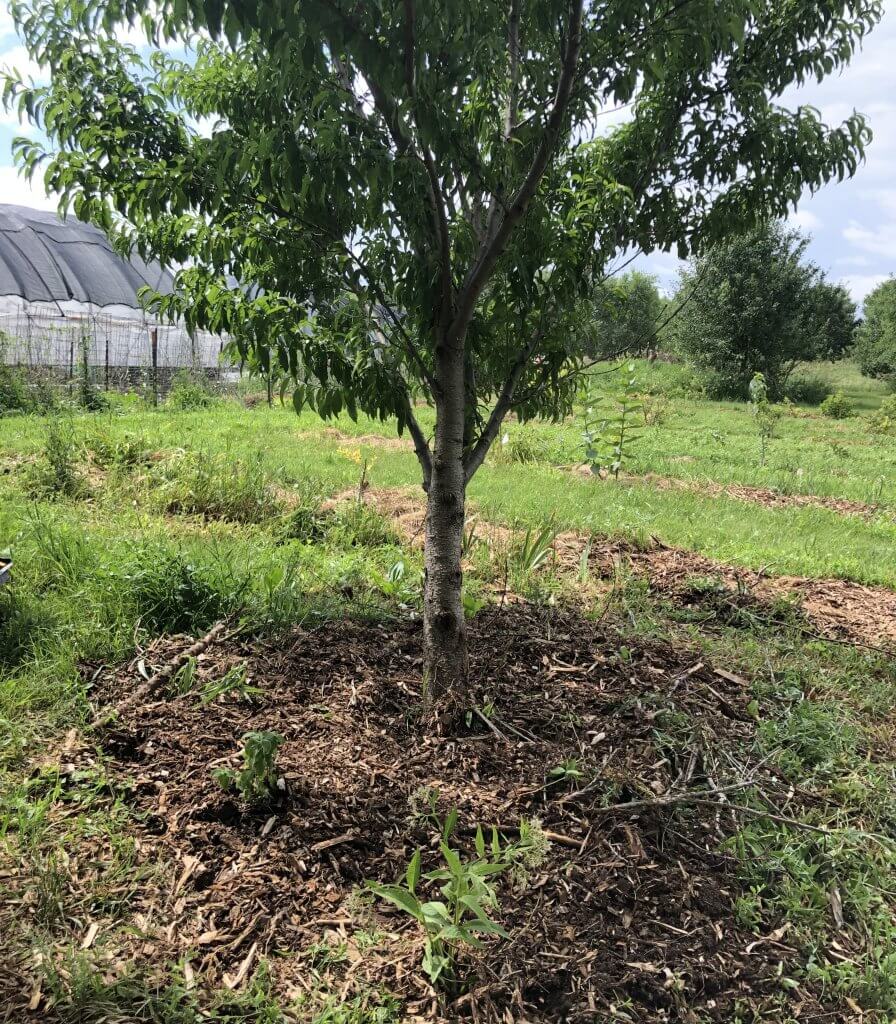
After! Though you can’t see the companion plants very well, they are planted, watered in, and are surrounded with mulch. I’m excited to watch them fill in the space!
Say you’re ready to plant a guild around your fruit tree?
Here’s how to do it.
- First, put down a thick layer of cardboard (wet it down to keep it in place) to choke out the grass underneath the tree.
- Cover the cardboard with a couple of inches of compost, then an inch or two of mulch. (I use wood chips when I have them).
- Plant your plants in a ring around the estimated mature size (or the drip line) of your tree. Cut holes in the cardboard (if necessary) to plant. Water new plants as necessary.
- Observe and experiment.
Further reading on permaculture
My son Matthew (who is a year or two ahead of me in study of this subject) recommends:
Gaia’s Garden: A Guide to Home-Scale Permaculture, 2nd Edition by Toby Hemenway
Resources on permaculture are rife on the interwebs. For example, look here for lists of what plants attract which beneficial insects.
I’ve also found this website to be invaluable.
Tools you probably need to plant your fruit tree guild
- This little saw, of course, if you are serious about pruning your fruit trees.
- I promise you this is the handiest thing for planting plants.
- I’m a smaller person and really love a smaller shovel. My mom gave me a smaller D-handle shovel like this one years ago, and I use it nearly every day.
One last thought
The time you spend planting fruit trees will never be wasted. I’ve been amazed at how much fruit my mature trees now produce. I am looking forward to many more years of picking my own fruit! It makes a lot of sense to me to do what I can to insure that the trees are as healthy and productive as they can be.

Scout and Capone, wishing a deer would show up on the other side of the fence so they could chase it.
Thanks for popping in! Have you ever planted companion and/or beneficial plants around your fruit trees? What did you learn? Drop me a line in the comments below!
Pin it for later!
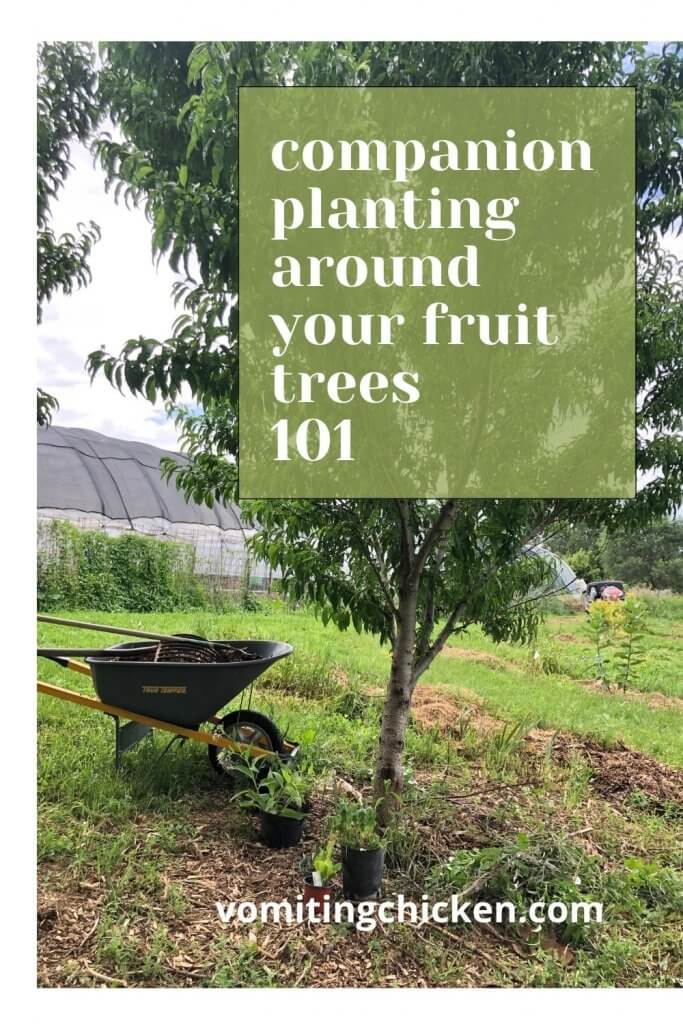


Amy – I have been in your orchard many times and know how much fruit you can produce. Interesting and informative article above. BUT . . . you forgo to mention one very important factor – pollinators. Bees. Your orchard and mine are about the same age but since the honey woman who used to keep a couple of hives on my property removed the hives a couple of years ago my gorgeous 20 year old apple, plum and pear trees have produced not a fruit, nothing, nada. And I’ve seen exactly one monarch, one black swallowtail and one lonely bumblebee this year.
Gene,
I know that there aren’t as many pollinators as there used to be. I’ve been amazed, however, at how many bumbles and other types of bees I’ve seen this year. I’d be happy to give you starts to comfrey plants. Mine are always buzzing with bumbles and other bees, too. Perhaps we need to plant more plants that attract pollinators around our fruit trees than we used to!?
I planted a couple Reliance peach trees 3 years ago, and like you, I’m wondering if I’ll ever get to eat anything from them. Here in NE Ohio, late freezes are the rule rather than the exception, but at least the trees are nice and growing well! When I planted them, I threw caution and advice to the wind and decided to underplant with clover for weed suppression, and my red raspberries are planted nearby along with buckwheat for my bees. This plan has worked really well!
Kristine, you instinctively planted beneficial plants near your Reliance peach trees! I do hope you get a harvest. Peach trees of any kind here in Nebraska are such a gamble. The stone fruit borer is a primary killer of peach trees, and it’s so seldom that we get a good peach year. But . . . mama . . . when we get a big peach harvest, it is totally worth the trouble!! Our experience has been that we get 3 good harvest years before the peach trees succumb to the borers. But I just keep planting them. Best wishes with your Reliance peach trees!
Good grief, sometimes I can’t see the forest for the trees! I put in some peach trees last year and have been wondering what to plant around them. At the same time I’ve been marveling at my asparagus going King Kong after being invaded by the boisterous comfrey. Thanks for putting the pieces in place for me. Comfrey around the peaches will happen!
I have been wanting to plant comfrey for our rabbits for a while. I think I will plant some plants around our fruit trees. Win-win!
Comfrey is an exceedingly useful plant, Ashley, so your instincts are not wrong! Just remember to plant your plants around the dripline of your trees, so they don’t compete for water and nutrients. Good luck!!
Amy, thanks for this info…comfrey and Egyptian walking onions are in my plan now. But bugs…what is in your jugs to help with that?
Barb, Here’s a post I wrote about an all-natural fruit tree insect “bait” that I hang in jugs in my orchard every spring.
https://vomitingchicken.com/all-natural-bug-repellent-for-fruit-trees-it-works/
Exactly what I was looking for! Where can I find more info about specific trees? About to plant lemon, clementine, mango and papaya in our community garden and I’m dying to do this
Tania, I would check out books on permaculture, actually! My son Matthew read them all, and he’s a real master in planting companion plants around fruit trees. I know he’s mentioned “Restoration Agriculture” by Mark Shepherd, and Gaia’s Garden by Tony Hemenway. I’m sure there are lots of good ones out there!
Pingback: Optimize Orchards: Best Companion Plants for Fruit Trees